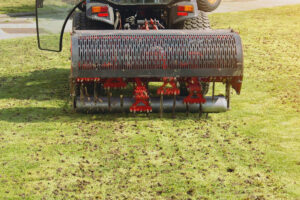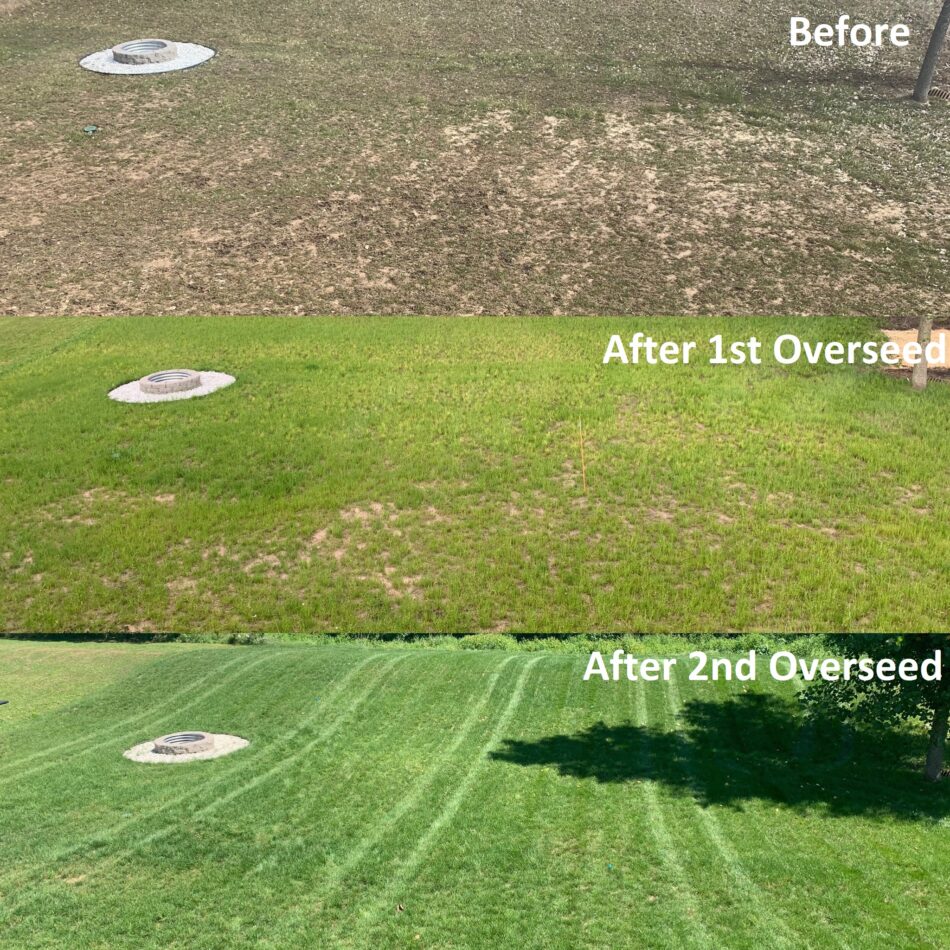 Maintaining a lush, vibrant lawn is a goal shared by many homeowners, but achieving this can be a constant battle against environmental stressors, foot traffic, and other lawn challenges. Two powerful lawn care techniques – aeration and overseeding – can be your secret weapons in the quest for a greener, healthier turf. By understanding the benefits of these practices and how to implement them correctly, you can transform your outdoor space into the envy of the neighborhood.
Maintaining a lush, vibrant lawn is a goal shared by many homeowners, but achieving this can be a constant battle against environmental stressors, foot traffic, and other lawn challenges. Two powerful lawn care techniques – aeration and overseeding – can be your secret weapons in the quest for a greener, healthier turf. By understanding the benefits of these practices and how to implement them correctly, you can transform your outdoor space into the envy of the neighborhood.
Understanding Aeration
Aeration is the process of creating small holes or perforations in the soil of your lawn. This simple yet effective technique serves several crucial purposes:
Reducing Soil Compaction
Over time, the constant foot traffic, mowing, and natural settling of the soil can lead to compaction. This dense, tightly packed earth makes it difficult for air, water, and essential nutrients to reach the roots of your grass. Aeration alleviates this problem by breaking up the compact soil, allowing for better circulation and absorption of these vital elements.
Improving Nutrient Uptake
With the soil loosened through aeration, your grass’s root system can more efficiently take in the nutrients it needs to thrive. This enhanced nutrient availability leads to stronger, healthier blades and a lush, vibrant lawn.
Stimulating Root Growth
The perforations created by aeration provide an ideal environment for your grass’s roots to grow deeper and spread more extensively. This robust root system not only anchors your lawn firmly in place but also makes it more resilient against drought, pests, and disease.
Promoting Thatch Decomposition
Thatch, the layer of dead and decaying organic matter that can build up on the soil surface, can inhibit the flow of air, water, and nutrients to the roots. Aeration helps to break down this thatch layer by exposing it to the beneficial microorganisms in the soil that feed on and decompose it.
Choosing the Right Aeration Method
When it comes to aeration, there are two primary techniques to consider: core aeration and spike aeration.
Core Aeration
Core aeration involves using a machine with hollow tines or spikes that remove small plugs of soil from the lawn. This method is generally considered the most effective, as it physically removes compacted soil and creates channels for air, water, and nutrients to penetrate the root zone.
Spike Aeration
Spike aeration, on the other hand, simply pokes holes in the soil without removing any cores. While this approach can provide some benefits, it does not alleviate soil compaction to the same degree as core aeration. The holes created by spike aeration can also become quickly sealed up, reducing their long-term impact.
For optimal results, experts recommend using a core aerator, as it provides the most comprehensive and long-lasting benefits for your lawn.
Timing Your Aeration
The timing of your aeration efforts is crucial, as it should align with the peak growing season for your particular grass type. This ensures that your lawn has the best chance of recovering and thriving after the aeration process.
Cool-Season Grasses
If your lawn is dominated by cool-season grasses, such as Kentucky bluegrass, perennial ryegrass, or tall fescue, the ideal time to aerate is in the early fall or early spring. These periods coincide with the active growth phase for cool-season turf, allowing the grass to quickly heal and fill in any gaps created by the aeration.
Warm-Season Grasses
For lawns with warm-season grasses, like Bermuda grass, Bahia grass, or St. Augustine grass, the optimal aeration window is in the late spring or early summer. This timing aligns with the peak growing season for these warm-weather-loving species, enabling them to take full advantage of the aeration benefits.
Regardless of your grass type, it’s essential to avoid aerating during periods of extreme heat or drought, as the stress of the aeration process can further compromise the health of your lawn.
The Power of Overseeding
Overseeding is the practice of spreading grass seed over an existing lawn, with the goal of introducing new, vibrant grass plants to fill in bare spots and create a thicker, more uniform turf. When combined with aeration, overseeding can take your lawn to new heights of lushness and resilience.
The Benefits of Overseeding
Overseeding offers several key advantages:
-
- Filling in Bare Spots: By sowing new grass seed, you can address any thin or patchy areas in your lawn, creating a more cohesive and visually appealing landscape.
- Increasing Density: The addition of new grass plants helps to thicken up the existing turf, making it more resistant to weed invasion and environmental stressors.
- Introducing Disease-Resistant Varieties: When overseeding, you can choose grass seed varieties that are better equipped to withstand common lawn diseases, pests, and other challenges.
- Enhancing Drought Tolerance: Some overseeding seed mixes include grasses that are more drought-tolerant, helping your lawn better cope with periods of limited rainfall.
Timing Your Overseeding
As with aeration, the optimal time to overseed your lawn is closely tied to the growth cycles of your specific grass type. For cool-season grasses, the best window is typically in the early fall, while warm-season grasses thrive when overseeded in the late spring or early summer.
Combining Aeration and Overseeding
The true power of these lawn care practices lies in their synergistic relationship. Aerating your lawn first creates the ideal conditions for overseeding to be successful, as the perforations in the soil allow the new grass seed to make direct contact with the earth and establish strong roots.
Preparing the Lawn
Before you begin the aeration and overseeding process, take the time to properly prepare your lawn. This includes:
-
- Mowing the grass slightly shorter than usual to ensure the seed has easy access to the soil.
- Removing any debris, such as leaves, sticks, or thatch, that could interfere with the aeration and seeding process.
- Watering the lawn thoroughly a day or two before aerating to ensure the soil is moist and easier to penetrate.
The Aeration and Overseeding Process
-
- Aerate the lawn using a core aerator, making multiple passes in a criss-cross pattern to create a dense network of perforations.
- Immediately follow the aeration with overseeding, spreading the grass seed evenly across the lawn using a broadcast or drop spreader.
- Gently rake the seed into the soil to ensure good seed-to-soil contact, then water the area thoroughly.
- Continue to water the lawn daily for the first 2-3 weeks, or until the new grass seedlings have germinated and begun to establish themselves.
Avoiding Common Mistakes
While aeration and overseeding can be incredibly beneficial for your lawn, there are several pitfalls to watch out for:
- Choosing the Wrong Equipment: Opt for a core aerator over a spike aerator to ensure effective soil decompaction.
- Improper Aeration Technique: Be sure to disengage the tines when turning the aerator to prevent additional compaction.
- Timing Errors: Aerate and overseed during the optimal growth periods for your grass type.
- Neglecting Moisture: Keep the lawn consistently moist after overseeding to promote seed germination and establishment.
- Mowing Too Soon: Wait 2-4 weeks before mowing the lawn to allow the new grass seedlings to develop strong roots.
- Premature Weed Control: Hold off on applying herbicides or other weed control products until the new grass has had a chance to mature.
The Benefits of Professional Lawn Care
While aeration and overseeding can be DIY projects, entrusting these tasks to a professional lawn care service can ensure optimal results. Experienced technicians have the right equipment, knowledge, and attention to detail to execute these processes flawlessly, maximizing the impact on your lawn’s health and appearance.
Additionally, a professional lawn care provider can offer ongoing maintenance and monitoring to keep your lawn in top shape throughout the year. From regular mowing and edging to targeted fertilization and pest control, these experts can help you achieve the lush, vibrant outdoor space you’ve always desired.
A&A Provides Aeration and Overseeding Services
Aeration
Too much thatch can choke your lawn. For many years, professional golf course greens keepers have known that the secret to a beautiful, dense turf is aeration. By aerating their courses two to three times each year the grass roots grow more healthy and the plants thrive!
> Learn More About AerationOverseeding
The lawn you choose should be sown, fed and re-seeded according to its type. For cool season favorites like perennial rye, Kentucky bluegrass and the fescues, the time to sow seed—whether to fill in bare spots or plant a brand new lawn—is in the “Fall”, actually mid-August to mid-September.
> Learn More About Overseeding
Aeration and overseeding are powerful tools in the quest for a beautiful, healthy lawn. By understanding the benefits of these practices, choosing the right techniques, and timing them correctly, you can transform your outdoor space into a lush, verdant oasis that the whole neighborhood will envy. Whether you tackle these tasks yourself or entrust them to a professional lawn care service, the rewards of a thriving, well-maintained lawn are well worth the effort.
Contact Us (859-384-0266) for a Free Consultation!
Get an Instant Quote
—
 About A & A Lawn Care & Landscaping
About A & A Lawn Care & Landscaping
A & A Lawn Care & Landscaping can beautify your lawn and landscaping using our vast experience in turf grass management. Our complete lawn service is designed for both residential and commercial lawns and we keep your lawn healthy without harming your family, staff, or pets.
> Learn More
